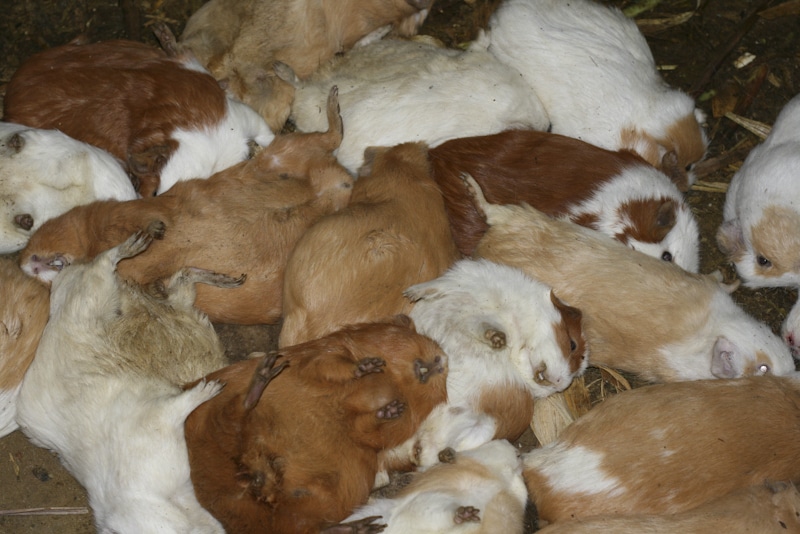Guinea Pig:
What is it?, History, cultivation, nutritional value, uses, recipes, and more...
The guinea pig is a rodent mammal native to the Andean region of Bolivia, Colombia, Ecuador, and Peru. In Peru, it is consumed as meat with high nutritional value and serves as an important nutritional source for rural populations with limited resources.
The guinea pig is also a very social animal and a pet for many people around the world.
Índice
What is a Guinea Pig?
The guinea pig is a rodent with an elongated body covered in fur. Male individuals of the species develop larger than females, and they need to be picked up to determine their gender.
The guinea pig’s head is relatively large in relation to its body, conical in shape, and has varying lengths depending on its breed. Their ears are often droopy, although some have upright and smaller ears.
Their eyes are lively, round, and black or red in color, with shades ranging from light to dark. The snout is conical with small nostrils, a split upper lip, and an unsplit lower lip. Their incisor teeth are elongated and curve inward.
The guinea pig has short limbs, with its front legs being shorter than its hind legs. Its digits have short nails on the front legs and large, thick nails on the hind legs. It has 3 toes on the hind limbs and 4 on the front limbs.
History of the Guinea Pig
There are records indicating that the guinea pig was domesticated between 2,500 to 3,600 years ago. Abundant deposits of guinea pig excrement have been found in stratigraphic studies conducted at the Cerro Sechín temple in Peru and in the early period of the Paracas culture called Cavernas (250 to 300 BC). They were already consuming guinea pig meat during this period. It is believed that by the third period of this culture (1400 AD), most households had guinea pig enclosures. Ceramics found in Mochica and Vicus vessels illustrate the importance of this mammal in the nutrition of the time.
Additionally, guinea pig remains have been found in Ancón, Huaycán ruins, Cieneguilla, and Mala.

Common Name of the Guinea Pig
| Colombia, Ecuador y Perú | Cuy |
| Países del Caribe y Andalucía | Acure, curí, curio, cury |
| Huánuco, Áncash, Pasco y Junín | Jaca o aca |
| España y ciertas zonas de Hispanoamérica | Cobayo y cobaya |
| Italiano | Cavia peruviana o porcellino d’India |
| Portugués | Porquinho da Índia |
| Francés | Cochon d’Inde o cobaye |
| Inglés | Guinea pig |
| Alemán | Meerschweinchen |
| Ruso | Mорская свинка o morskáia svinka (‘cerdito de mar’) |
| Indonesio | Tikus belanda (‘ratón neerlandés’) |
| Puerto Rico | Güimo |
Scientific Name of the Guinea Pig
Cavia porcellus
Taxonomy of the Guinea Pig
| kingdom | Animalia |
| Filo | Chordata |
| Class | Mammalia |
| Order | Rodentia |
| Suborder | Hystricomorpha |
| Infraorder | Hystricognathi |
| Family | Caviidae |
| Subfamily | Caviinae |
| Gender | Cavia |
| Specie | C. porcellus (Linnaeus, 1758) |
Synonymy of the Guinea Pig
Mus porcellus Linnaeus, 1758
Cavia cobaya Pallas, 1766
Cavia anolaimae Allen, 1916
Cavia cutleri Bennett, 1836
Cavia leucopyga Cabanis, 1848
Cavia longipilis Fitzinger, 1879
Etymology of the Guinea Pig
Guinea Pig: The word comes from the Quechua term “quwi,” an onomatopoeic name that is still used in some regions of South America.
Habitat of the Guinea Pig
- Habitat
Habitat of the Guinea Pig
The habitat of the guinea pig is extensive. Numerous groups are distributed along the Andean mountain range in Venezuela, Colombia, Ecuador, Peru, Bolivia, Argentina, and Chile. It is believed that the territory occupied by Peru and Bolivia was the core habitat of this genus. This small mammal lives below 4,500 meters above sea level, in coastal and highland jungle regions.
Furthermore, the habitat of the wild guinea pig is even more extensive. There are specimens of this species from Central America, the Caribbean, and the Antilles to southern Brazil, Uruguay, and Paraguay in South America.
There are 3 forms of guinea pig production: family-based, family-commercial, and commercial. The development of breeding in rural areas has led guinea pig producers to transition through these three systems.
Family-based breeding is the most widespread in the Andean region of Peru and is characterized by being mainly based on household inputs and labor.
Among the types of guinea pigs, the native breeds constitute the predominant population. These animals are characterized by being small, hardy, not very demanding in terms of the quality of their food. They thrive even in adverse weather and feeding conditions. Technical breeding improves their productivity, with class separation achieved through the use of enclosures, allowing their production to triple (Higaonna et al., 1989b).
Under good conditions, guinea pigs live an average of six years, with a maximum lifespan of eight years; although their productive life is suitable for 18 months, it can extend up to a maximum of four years.
To start raising guinea pigs, it is recommended to acquire around 10 to 12 females and one male. For mating, it is preferable that males are at least six months old and females three months old.
Females go into heat for 8 to 10 hours every 18 days and can remain in this state for 15 to 20 days. The first postpartum heat occurs two hours after giving birth. Their gestation period is 67 days, and the offspring nurse for a month after birth. On average, each female has between four to five litters per year.
A few days before giving birth, each pregnant female is moved to a separate enclosure to prevent the young from hurting each other. The young are separated from their mother after 15 days.
Geographical Distribution of the Guinea Pig

Cajamarca, Cusco, Áncash, Apurímac, Junín, Lima, La Libertad, Ayacucho, Arequipa, Lambayeque
Year-Round Availability of the Guinea Pig
- All year
Varieties of the Guinea Pig
In Peru, there are four guinea pig breeds, benefiting over 800,000 families nationwide.
-
Peru Breed
-
Andean Breed
-
Inti Breed
-
Interracial Breed or "Synthetic Guinea Pig"
Nutritional Value of the Guinea Pig
The guinea pig is characterized by its low fat content compared to species like birds, sheep, cattle, and pigs. It has a high protein and iron content, low sodium, and contains essential fatty acids that contribute to nervous and intellectual development. This makes it very useful in the diet of children at risk of malnutrition and anemia.
Among the most important minerals it provides are Calcium, Phosphorus, Zinc, and Iron. Additionally, it contains vitamins such as Thiamine, Riboflavin, and Niacin.
Guinea pig meat has high digestibility, low levels of cholesterol and triglycerides, high presence of linoleic and linolenic fatty acids, which are precursors to the formation of arachidonic acid (AA) and docosahexaenoic acid (DHA). Both acids are essential for neuron and cell membrane development.
Furthermore, it has been proven that its meat contains a lot of collagen and helps prevent or combat arthritis and osteoarthritis.
Health Benefits of the Guinea Pig
Guinea pig meat is rich in proteins and contains important minerals and vitamins.
Contraindications or Side Effects
There is no evidence to date that consuming guinea pig meat has adverse effects or interactions with drugs.
| 10 Porciones por Kilogramo | |
| Tamaño de porción | 100g |
| Cantidad por porción Calorías |
96 |
| Cantidad por 100g | |
| Energía | 402 kJ |
| Grasa Total | 1.6 g |
| Sodio | ● |
| Carbohidratos totales | 0.1 g |
| Carbohidratos disponibles | 0.1 g |
| Fibra Dietaria | 0.0 g |
| Proteínas | 19.0 g |
| Calcio | 29 mg |
| Fósforo | 258 mg |
| Zinc | 1.57 mg |
| Hierro | 1.90 mg |
| Potasio | ● |
| Agua | 78.1 g |
| Cenizas | 1.2 g |
| Vitamina A | 0 μg |
| Tiamina (B1) | 0.06 mg |
| Riboflavina (B2) | 0.14 mg |
| Niacina (B3) | 6.50 mg |
| Vitamina C | 0.00 mg |
| Acido Fólico (B9) | ● |
| β-Caroteno | ● |
| Fuente: Tablas peruanas de composición de alimentos – Centro Nacional de Alimentación y Nutrición – Ministerio de Salud – Perú | |
Derived Products and Ways of Consuming Guinea Pig
Uses of the Guinea Pig
The primary use of the guinea pig is for its meat consumption by humans. This rodent is highly valued as a gastronomic ingredient and is used in renowned flagship dishes of Peruvian cuisine. Additionally, it possesses nutritional properties that contribute to its…
- Culinary
- Medicinal
- Ritual
Culinary Use of the Guinea Pig
The consumption of guinea pig is a practice that many people may reject, but in Peru, the versatility of its meat in gastronomy has made it the star of many well-known dishes.
Among the emblematic dishes prepared from guinea pig, you can find: cuy chactado (crispy guinea pig), adobo de cuy (marinated guinea pig), picante de cuy (spicy guinea pig), enrollado de cuy (rolled guinea pig), consomé de cuy (guinea pig broth), piscuy (guinea pig ceviche), cuy a la caja china (guinea pig cooked in a box), cuy al palo (guinea pig on a spit), and the innovative chijau cuy, which represents the fusion of national and Chinese cuisine.
Some nutritionists recommend consuming this meat in preparations like stews, baked dishes, or marinated versions to maximize its nutritional benefits. These benefits are lost by 30% when grilled and 60% when fried.
There is also the option to consume guinea pig blood sausage, which is an excellent source of iron for preventing childhood anemia.
Medicinal Use of the Guinea Pig
Guinea pig meat can be preventive not only because it's low in fat but also because it contains more protein and amino acids than the meat of many other animals. Studies reveal that this meat helps prevent various types of cancer. Additionally, traditionally in Peru, guinea pigs were used to diagnose diseases afflicting citizens. Since pre-Inca times, healers would pass this animal over the bodies of their patients to absorb the illnesses, after which the guinea pig would die. By analyzing the inside of the animal, a specific affected organ could be determined, leading to a solution.
Ritual Use of the Guinea Pig
It is known that guinea pigs were used for ritual purposes as offerings, as remains have been found in burials dating back to 2500 BC at the Temple of the Crossed Hands of Kotosh, in Huánuco.
There is a ritual practice of traditional Andean medicine in Peru and Ecuador that has been recorded since the 16th century and is still performed today. It's called "La shoqma," also known as "soba with cuy." In this practice, the guinea pig is used to "cleanse" and/or diagnose a person's health issue. In this ritual, the animal is rubbed on the patient's body, and usually, the guinea pig dies at the end. The ritual burial of the guinea pig is part of the ceremony.
This ritual varies based on the tradition and/or lineage of the healer. A male guinea pig is used if the patient is male, and a female guinea pig if the patient is female. Typically, a black guinea pig is preferred, over one month old, and less than three months old.



